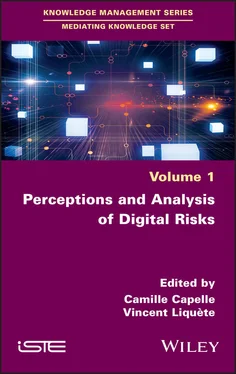Educational response and research
Risk has become a social and informational reality, both objective and subjective, “that drives us to act”. Its integration as a regulated condition of the informational experience supposes an intelligence and an experience of the activity shared with the students. The integration of the risk dimension in teaching and learning activities is associated with “media literacy” in our educational system. Its objective is the awareness and management of students’ activity in an information environment. The ability to assess digital risks and the possibility of managing events/information in a critical way are the horizon. Media education opens up, beyond the mastery of informational tools, by taking into account the fragility of information systems or illicit uses, to the informational experience and to an information culture. It is not a matter of protecting ourselves from risk, but of designing support for students that is adapted to information contexts. “Risk education”, integrated into teaching and learning, examines the new skills required for an information society, as well as pedagogical mediation. Risk education integrated with information literacy responds to the need for the new regulations (Beck) required for an information society. Different paths, the plurality of situations and uses, are thus to be explored in the educational field. The notion of risk, as a condition, is not a limit to be fixed but a critical tool within learning.
This book brings together various contributions at the intersection of professional action and research. The proposed analyses are in line with the second edition of the conference “Knowledge and Information and Information in Action (CIA)” entitled “From risk perceptions to action in a digital context” held on April 3 and 4, 2019 at the University of Bordeaux, France, organized around the project eRISK (Education 2.0 and “digital” risks; representations and pedagogical practices) led by the RUDII-IMS team 8. It proposes a renewed focus on the perceptions of risks in the educational and professional context. Different paths for research and action are presented: those of the subjective dimension of risk perception in the shaping of practices and the construction of action strategies in a situation 9; or those of objectivizing analyses of an information ecology (arena) and the organization of action devices. The epistemological limits of information sciences are questioned as much as the uses and practices.
Risk belongs to the cultural transpositions linked to digital technology. It becomes a principle of activity in an uncertain world, a critical and social component in support of education. This research contributes to its understanding and its reflexive inscription in information, “academic” and societal behaviors.
Franc MORANDI
September 2021
1 1 Beck, U. (1986). La société du risque : sur la voie d’une autre modernité. Flammarion, Paris.
2 2 Capelle, C. (2018). Rapport final de projet de recherche eR!SK – risques numériques et école 2.0. Research report, IMS Laboratory, University of Bordeaux, Bordeaux.
3 3 Citton, Y. (2017). The Ecology of Attention. Polity Press, Cambridge.
4 4 Cordier, A. (2017). Les enseignants, pris dans des injonctions paradoxales. Hermès, La Revue, 78(2), 179-186.
5 5 Bruner speaks of implicit theories: “It is not enough to describe what the child is doing: we must be able to determine what they think they are doing and why”. Bruner, J. (1998). Le développement de l’enfant : savoir-faire, savoir dire. Presses Universitaires de France, Paris.
6 6 Dioni, C. (2008). Métier d’élève, métier d’enseignant à l’ère numérique : rapport de recherche pour l’INRP. INRP, Paris.
7 7 Capelle, C. and Rouissi, S. (2018). Représentations et stratégies de jeunes enseignants face aux réseaux sociaux. Les Cahiers du numérique, 14(3–4), 13–34.
8 8 RUDII: Représentation Usages et Développement des Ingénieries de l’Information, IMS: laboratoire de l’Intégration du Matériau au Système (IMS, CNRS UMR 5218). CNRS, l’Université de Bordeaux, INSPE d’Aquitaine (2016–2019). Projet eRISK: “Risques numériques et école 2.0 Éducation des jeunes générations et responsabilité des enseignants”. Hypothèses [Online]. Available at: https://erisk.hypotheses.org/category/projet.
9 9 Lave, J. and Wenger, E. (1988). Situated Learning. Legitimate Peripheral Participation. Cambridge University Press, New York.
In recent years, the notion of digital risk has invaded the media. Numerous publications suggest that digital technology is a source of all sorts of threats, whether at the informational, psycho-social, ethical, cognitive, health, technical, socio-economic, legal or environmental level. For example, we can cite the denunciation of the risks of addiction and “techno-addiction” linked to screens among young people 1or the impoverishment of reading practices 2and thought 3. This risk-based approach tends to solidify the description of individual and social practices in categories that do not reflect their evolution and diversity, nor the capacity of actors to innovate, which implies taking risks.
The intention of this book is to go beyond a stigmatizing approach to risk. Instead, it is to consider it as the center of discourses, representations and practices. It is necessary to deconstruct and understand it in order to propose tailored support.
According to Ulrich Beck, “risks designate a future that must be prevented from happening”. Real and imaginary at the same time, they are, in his view, “an event that has not yet occurred which motivates action” 4. This “growing appearance of risk in the world” is also denounced by Patrick Peretti-Watel. For him, risk “is a danger without cause, a damage without fault, which nevertheless becomes predictable and calculable” 5. The perception of digital risks therefore motivates individuals to act, but how? And in what ways? How do they critically assess their practices?
The term digital risk is often used to designate the dangers linked to the security of computer systems, particularly in computer science and management science. The field of law is also concerned notably around the problems of information security, personal data protection 6and e-reputation 7. Other publications also concern ethical issues, in sensitive areas of personal information protection, such as health.
In psychology, digital risks are treated from the point of view of cognitive overload 8and addictions 9. The notion of informational risk is often linked to knowledge management 10, problems of manipulation and critical evaluation of sources 11and information asymmetry 12. For the manager of a company, the digital risk is linked to the security of data, strategic information or the reputation of the company.
With regard to education and the perception of risks associated with the use of digital technologies, a report published by Christine Dioni in 2008, (The student’s job and the teacher’s job in the digital age), emphasized the problems of discrepancy between the perceptions of students and teachers, as well as between mutual perceptions and the reality of practices 13. Just over 10 years later, what is the situation now?
The stakes of digital practices in terms of learning 14and the socioeconomic risks linked to the digital divide 15lead the actors of education to ponder effective means of confronting them. The idea of media risks is also used to denounce inappropriate content, such as violence, incitement to hatred or pornography on the Internet, calling for the establishment of standards 16. The risk of ideological and political manipulation is currently back in the media spotlight through the analysis of conspiracy theories, the topic of “fake news” and young people’s susceptibility to propaganda.
Читать дальше












